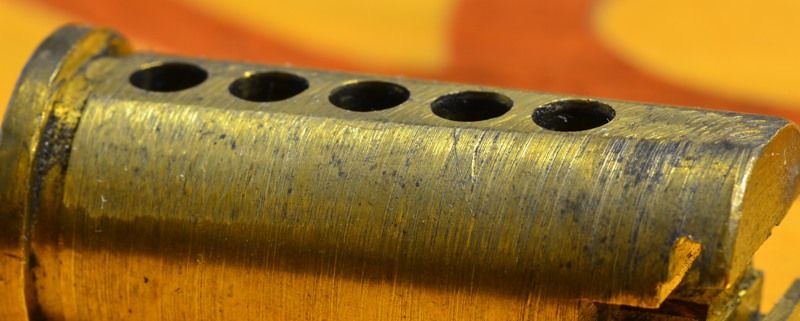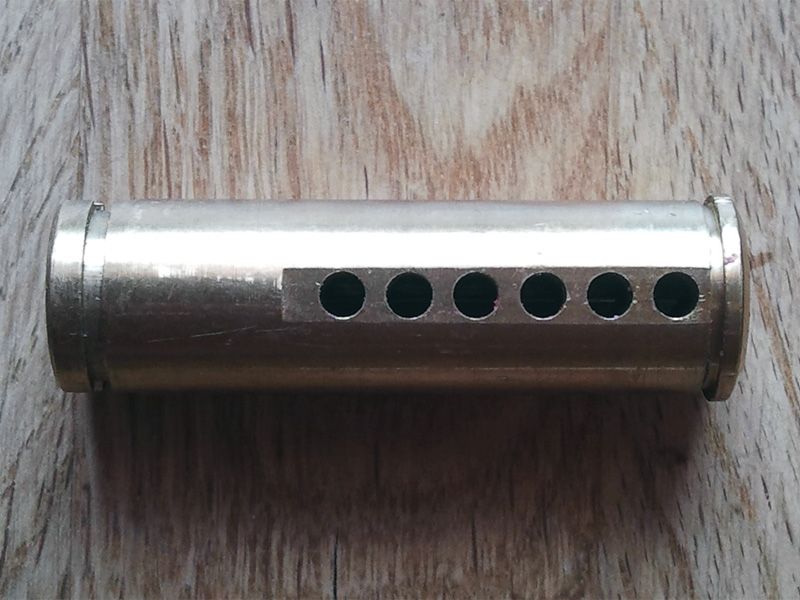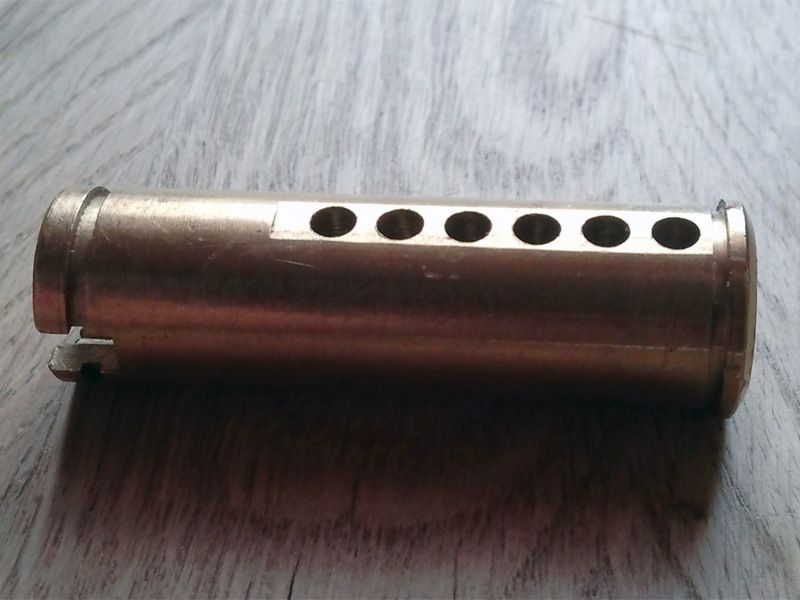|
Having read the FAQ's you are still unfulfilled and seek more enlightenment, so post your general lock picking questions here.
Forum rules
Do not post safe related questions in this sub forum! Post them in This Old Safe
The sub forum you are currently in is for asking Beginner Hobby Lock Picking questions only.
 by globallockytoo » 2 Jan 2013 0:34 by globallockytoo » 2 Jan 2013 0:34
if you are onsite and dont have the correct pins with you to do the job properly, you need to find a way to satisfy your customer and get paid immediately without running back and forward from workshop to job site.
So, what do you do?
Yes, we all know that it is poor form to file the top of the barrel and reaming the pin holes is certainly the better solution.
However, I remember attending the Lockwood factory in Huntingdale many years ago and watching the ladies in the keying room pinning up the old style 234 padlocks. Before the days of computerised assemblers, the ladies were required to pin many padlocks as quickly as possible. We apprentices on the tour were horrified to see the keying ladies pin all chambers to a 9 depth and use a 12" rasp to bring the pins down to the shearline height.
If it was accepted by the factory (at that time), why shouldnt a locksmith perform that out on the road? If you do not have access to the correct size pin or you dont have a drill to ream the chamber......you are going to use whatever is in your arsenal of knowledge to get the job done for the customer as quickly and cheaply as humanly possible. Yes, we know it is wrong, but when faced with a situation on the road to solve issues and the customer refuses to pay for the correct solution, then sometimes you have to go against your integrity and file the barrel!
One One was a race horse, one one won one race, one two was a racehorse, one two won one too.
Disclaimer: Do not pull tag off mattress. Not responsible for legal advice while laughing.
Bilock - The Original True Bump Proof Pin Tumbler System!
-
globallockytoo
-
- Posts: 2269
- Joined: 26 Jul 2006 13:33
 by lunchb0x » 2 Jan 2013 3:32 by lunchb0x » 2 Jan 2013 3:32
cledry wrote:Yes, I understood what you were saying. You turn the pin upside down and file a bit off the point and then put it back in the right way, but you have no way to gauge how much to remove as the pin when upside down won't rest at the correct height. I have to ask why do this and not remove it from the top of the pin? I've never had a problem removing material from the top, it removes a bit of the bevel but operationally it works smoothly.
What do you mean that you have no way gauge how much to take off? put the pin in the correct way, look at how much needs to be taken off, turn pin upside down and file, if your unsure of how much just take a little off each time, we aren't talking about a lot of material here, it's a 1 minute job. As for filing the tops of pins, the tops of the pins have a chamfer to help the lock turn smoother, filing it flat removes this, filing the bottom of the pin doesn't effect this. also with the pin upside down in the lock the tip of the pin sits higher than the barrel ( With what we have over here anyway) so when filing you don't remove anything off the barrel, file the tops of the pins with them in the barrel and it's easier to take a bit off the plug, it's also not practical with time putting each pin in a vice to file them.
-
lunchb0x
- Supporter

-
- Posts: 1227
- Joined: 25 Nov 2006 12:10
- Location: Australia
 by zeepia » 5 Jan 2013 7:24 by zeepia » 5 Jan 2013 7:24
This is from Yale cylinder, someone has been enthusiastic about filing... Normal diameter is 12,90mm and from the filed portion´s other end it´s only 12,15mm  
-
zeepia
-
- Posts: 359
- Joined: 11 Jun 2012 22:25
- Location: Forest in Finland
 by Altashot » 5 Jan 2013 16:44 by Altashot » 5 Jan 2013 16:44
that is one fugly cylinder. Thanks for posting a picture of what NOT to do.
M.
-
Altashot
-
- Posts: 240
- Joined: 18 Aug 2012 20:43
- Location: Western Canada
 by minifhncc » 10 Feb 2013 8:54 by minifhncc » 10 Feb 2013 8:54
Lunchb0x,
I just rekeyed some locks today with new plugs and a code cut key. As usual, there was clicking no matter what pin size I used. So I tried your suggestion of choosing a larger size and filing the pointy part. But I still couldn't get the lock to work smoothly.
I ended up filing the top of the pins and therefore removing the chamfered surface. This worked like a charm and there was no more clicking. So it appears that the chamfered surface doesn't always help with ensuring a smooth operation...
What do you think was the problem here? At least I didn't file the barrel this time though.
Thanks
-
minifhncc
-
- Posts: 284
- Joined: 10 Jun 2011 23:03
 by cledry » 18 Feb 2013 17:57 by cledry » 18 Feb 2013 17:57
lunchb0x wrote:cledry wrote:Yes, I understood what you were saying. You turn the pin upside down and file a bit off the point and then put it back in the right way, but you have no way to gauge how much to remove as the pin when upside down won't rest at the correct height. I have to ask why do this and not remove it from the top of the pin? I've never had a problem removing material from the top, it removes a bit of the bevel but operationally it works smoothly.
What do you mean that you have no way gauge how much to take off? put the pin in the correct way, look at how much needs to be taken off, turn pin upside down and file, if your unsure of how much just take a little off each time, we aren't talking about a lot of material here, it's a 1 minute job. As for filing the tops of pins, the tops of the pins have a chamfer to help the lock turn smoother, filing it flat removes this, filing the bottom of the pin doesn't effect this. also with the pin upside down in the lock the tip of the pin sits higher than the barrel ( With what we have over here anyway) so when filing you don't remove anything off the barrel, file the tops of the pins with them in the barrel and it's easier to take a bit off the plug, it's also not practical with time putting each pin in a vice to file them.
You Australians always do things upside down.  It would take too long to turn each pin upside down, then file a bit, then turn it over again and re-test then remove and file a bit more and so on. Removing the bevel on the pin isn't really detrimental to smooth operation in my experience, many factory pins aren't beveled at all. Jim
-

cledry
-
- Posts: 2836
- Joined: 7 Mar 2009 23:29
- Location: Orlando
-
 by Luissen » 18 Feb 2013 21:01 by Luissen » 18 Feb 2013 21:01
itmight work temporarily and ensure job security, but it looks cringeworthy
If it works, it ain't wrong!  -GWiens2001
-
Luissen
-
- Posts: 112
- Joined: 14 Feb 2013 21:51
- Location: Connecticut (CT) USA
 by dll932 » 8 May 2013 20:14 by dll932 » 8 May 2013 20:14
I have seen it where apartment or office buildings have such crummy keys (worn or copies-of-copies), that I told them the only way I could be sure all the keys would work would be to rekey EVERYTHING. Also, filed cores and round pinning (using bottom pins as drivers) increases possibility of interchanges. When you charge for things you are culpable if you don't practice due diligence.
-
dll932
-
- Posts: 454
- Joined: 31 Mar 2013 22:42
- Location: Euclid, Ohio USA
Return to Got Questions? - Ask Beginner Hobby Lockpicking Questions Here
Who is online
Users browsing this forum: No registered users and 5 guests
|







